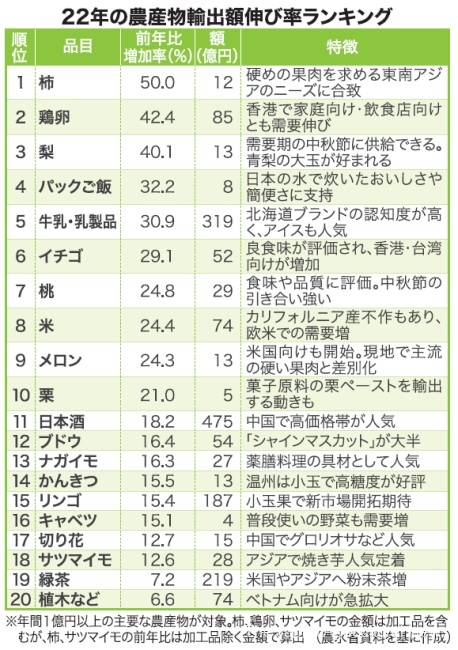Fruits dominate rankings of farm produce showing year-on-year rise in exports in 2022
TOKYO, Feb. 9 — Persimmons topped the list of agricultural items whose exports posted year-on-year increase in terms of value in 2022, and fruits occupied more than half of the top 10 products, according to rankings compiled by the Japan Agricultural News based on agriculture ministry statistics on farm produce exports.
Eggs and rice were also ranked high on the list. Exports of items which succeeded in meeting the needs of importing countries with their good taste and high quality unique to Japanese produce have risen in particular.
The Japan Agricultural News listed major agricultural products which recorded exports of 100 million yen or more in 2022 and ranked them according to the rate of year-on-year increase in overseas shipments in order to assess their potential in foreign markets.
Exports of persimmons showed the sharpest increase, rising 50 percent from a year before. The shipments increased at a high rate partly because of a rebound from low crop yields in the previous year, but exports of the fruit have been on a rising trend, up 1.9 times from five years before.
Persimmons matched the needs of major importing countries like Thailand where consumers tend to prefer hard flesh. Persimmon growing areas are also actively promoting exports of dried persimmons.
Chicken eggs came second, increasing 42 percent. Shipments to Hong Kong occupy 90 percent of the exports, with demands rising both for household consumption and commercial use.
“There are more restaurants which make Japan-produced eggs their selling point,” said an official involved in distribution of eggs in Hong Kong.
The future challenge will be stabilizing supplies which is becoming an issue amid bird flu outbreaks reported across Japan.
Demands for Japan-made products increased in part due to the global supply-demand situation and the weakened yen.
As for milk and dairy products, which ranked fifth, exports of skimmed milk powder rose as sellers tried to cut down inventories in Japan, and also because the price differences between Japanese-made and foreign products narrowed on the backdrop of reduced production in major producing countries leading to tight supply of dairy items globally.
Rice ranked eighth, as orders from Western countries increased due to reduced price differences between Japanese and foreign products in 2022 brought about by soaring prices of rice made in California, as well as the rising popularity of Japanese food and Japanese restaurant chains opening more locations.
Increases in exports of fruits were particularly high, with pears, strawberries, peaches, melons and chestnuts ranked in the top 10 along with persimmons.
Compared with five years before, exports of strawberries rose some three times while shipments of peaches, grapes and citrus fruits roughly doubled.
All fruits in general yielded a good harvest in 2022, providing sufficient supply, and a large volume of orders for pears and peaches came during the high demand season in September at the time of the Chinese Mid-Autumn Festival.
Particularly, good-tasting fruit varieties which can be differentiated from those made in other countries are proving popular and their exports are likely to expand further in the future.
Shine Muscat grapes bound for Hong Kong and Taiwan occupy most of grape exports, as the variety continues to attract wealthy consumers because of its good flavor.
Among citrus fruits, in addition to the main Unshu Mandarin oranges, exports of Chubankan varieties — citrus fruits other than Unshu Mandarin oranges that are grown in Japan — are showing an increasing trend.
Tochiaika, a strawberry variety grown in Tochigi Prefecture which is known for its good flavor and hard flesh, is also seen to have high export potential.
In February last year, Taiwan relaxed its ban on imports of farm produce from five prefectures in Japan including Fukushima, Ibaraki and Tochigi, put in place following the 2011 nuclear power plant accident in Fukushima.
Exports of items like strawberries, sweet potatoes and melons, which are grown widely in these prefectures, are expected to rise from now on.
Source: http://english.agrinews.co.jp/?p=10413

